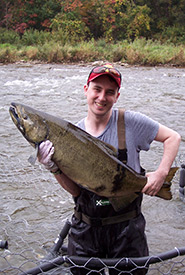The future of conservation is female (part two)
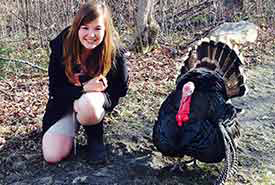
Esme Batten (Photo by Esme Batten)
In honour of International Women’s Day (March 8), over the course of the month, we are celebrating three young women working for the Nature Conservancy of Canada’s (NCC’s) Ontario Region. We speak with them to learn more about what led them to a career in conservation and the important conservation work they do for their respective natural areas. Last week we spoke to Jenna Siu, and we continue today with Esme Batten, coordinator of conservation biology for the Saugeen Bruce Peninsula.
NCC: How did you get involved with nature conservation?
Esme Batten (EB): I moved to Canada from the U.K. when I was five. I spent most of my life in Ottawa before moving to the Saugeen Bruce Peninsula to pursue a career in conservation in 2014. Luckily for me, the activities I love to do in my free time align very well with my career. You can often find me hiking, birding, botanizing, canoeing and walking waist deep into swamps in search of rare plants, birds and any other interesting flora or fauna. On a recent trip to the U.K., I took a jellyfish identification course. I also love to explore the rich swamps in the Everglades when visiting Florida.
Related content
NCC: Tell us about the Saugeen Bruce Peninsula.
EB: Most of my work with NCC is based on the Saugeen Bruce Peninsula, which is approximately three-and-a-half hours north of Toronto and is most well-known for its crystal clear waters, dramatic cliffs and endless hiking opportunities. The Saugeen Bruce Peninsula is a UNESCO World Heritage Site and is one of the most ecologically significant regions in the Great Lakes region. It is a stronghold for globally rare species and supports a rich diversity of rare natural communities. To date, NCC has helped protect almost 12,000 acres (4,856 hectares) of land in this amazing place and actively stewards approximately 5,000 acres (2,023 hectares).
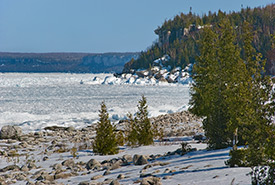
Saugeen Bruce Peninsula, ON (Photo by Kas Stone)
My days in this incredible place are often spent wandering through forests, wetlands and rare habitats in search of rare species, such as the threatened massasauga rattlesnake, as well as invasive or problematic species, such as phragmites.
In addition to boasting an incredible 44 species of orchids and over 20 species of ferns, the Saugeen Bruce Peninsula also supports the largest tract of contiguous forest in southern Ontario. However, with growing development pressures and a dramatic increase in tourism in the area, conservation work on the Saugeen Bruce Peninsula is more important than ever.
NCC: Tell us about a particular species of interest in your natural area.
EB: Those that know me know that I am a huge nature nerd! I particularly love reptiles and amphibians. The Saugeen Bruce Peninsula is known for its interesting array of herpetofauna (reptiles and amphibians), including Ontario’s only rattlesnake, the massasauga rattlesnake. The population of massasauga rattlesnakes on the peninsula is part of the most secure population in North America and is the second largest population in Ontario, with an estimated 8,000 to 10,000 individuals. It is listed as threatened in Ontario under the Endangered Species Act and is at risk of extinction. These docile snakes are most often found in forest openings, along the edges of wetlands or shorelines and basking along trails and roads. On average, adult massasauga rattlesnakes measure between 60 and 75 centimetres in length.
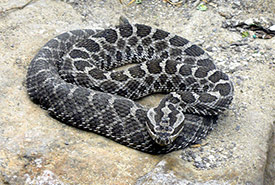
Massasauga rattlesnake (Photo by Tim Vickers)
Over the past two years, NCC staff on the Saugeen Bruce Peninsula have been trying to learn more about where these timid snakes can be found, so we can protect more of their habitat. We have a lot of information about where they can be found on the northern portion of the Saugeen Bruce Peninsula, although little is known about their southern range.
With the help of local partners such as the Bruce Peninsula National Park and Saugeen Ojibway Nation, NCC staff have been able to identify two populations of massasauga rattlesnake where they hadn’t been documented for about 50 years. While completing these surveys, we have also identified other populations of at-risk species and locally or provincially rare species that were previously unknown. Through learning more about where these snakes are found and gathering more information about their life history (i.e., what habitats they depend on), we are better able to protect them for future generations.
NCC: As you look to the future what do you see?
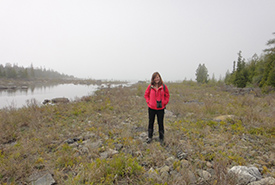
Esme Batten (Photo by NCC)
EB: Looking into the future of conservation, I think that one of the most important things will be for NCC and other organizations to continue to work collaboratively to both protect more of Canada’s natural landscapes and to effectively steward the land that we have already protected.
Working with local Indigenous communities and other local partners, we really have seen an increase in the pace of conservation throughout the Saugeen Bruce Peninsula. I see us continuing to develop our relationships to see what new and exciting projects we can work on together, whether it be completing our first prescribed burn on globally rare alvar communities, developing a peninsula-wide invasive species management strategy or coming up with new ways to complete at-risk species monitoring. I am really excited to see what the future holds!

